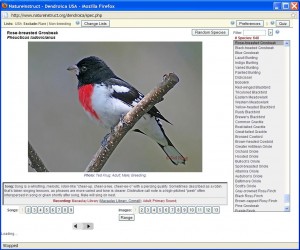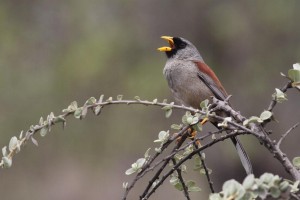Two New Warbler Websites

The title of this blog post is a little misleading – while both websites have warbler themed names, the real purpose of this blog is to announce two new nature sound resources. The first website I’m announcing today is Dendroica, a new identification resource for North American birds. Originally released back in 2007 on CD, it has just come to the web. Under their acknowledgments they state their main purpose as an “interactive training program developed originally to aid participants of the Breeding Bird Survey and other scientific surveys of Canadian bird species such as Breeding Bird Atlases to develop their bird song identification skills.”
The usefulness of this website extends far beyond those audiences, though. First you have to register as a user and get a username and password. Then the user can select one of three countries – Canada, the United States, and Mexico – to start, and then select from a list of species that occur in that country. For the US and Canada that list is near complete (I only noticed a few peripheral species not included, like Spectacled Eider). For Mexico there is obviously a lot of work to do, but hopefully the holes will be filled in as work on the site goes forward.
Once the user selects a species they are presented with sound recordings and photos of the selected species. The amount of audio Dendroica has is truly impressive, and draws from a wide variety of sources. Included are many species and many vocalizations not available elsewhere on the web, and the quality is universally excellent. At the moment coverage of some species is a little sparse, but presumably work is ongoing, and as more contributions are made this could become just about the most comprehensive collection of US bird songs available for free on the internet.
The little blurb below the photo gives a brief description of the primary song, and in some cases variation in song and calls. The source and documentation for the selected recording is shown just below this.
One other available feature that many users will find useful is a “quiz” button. Clicking this will give you a random sound and a list of possible answers.
Features I would really like to see Dendroica implement include more notes on what each recording includes. As it is you have to search the recordings for calls and alternate sounds/subspecies variation. If it were me, I’d divide the recordings up by vocalization type and subspecies. It would also be nice if there was more information on geographical and vocal variation.
I also find the automatic playing of one of the sounds when you select a new species account to be highly annoying, but that is in part personal preference. There are very few errors that I was able to find, quite an accomplishment when this many sounds/photos are in one place (but I also didn’t go through with a fine-toothed comb). What they have down for Omao (a Hawaiian Myadestes species) as song is actually the song of Brown-backed Solitaire, and another is that the recording they have for Black-capped Gnatcatcher either has a mislabeled location (California), or is mis-identified.
All in all I really like Dendroica, and highly recommend it.

The other new site I’m writing about here is my own, vermivora.com. I’ve just started working on it, and it’s still very much a work in progress. The main focus will be Neotropical, and will include photos, sounds, and trip reports from there and anywhere my travels take me.
The main focus of the sound part of vermivora, at the moment, will be sounds that I can’t post to xeno-canto (mammals, reptiles, and amphibians), and the “project” page. There I plan to post pages rather like the ID and taxonomy article posted here, but with a neotropical focus. Eventually this page will also include other sound resources of a tropical nature.
For an idea of what I’m talking about, take a look at the page on Inca-Finch vocalizations I posted. I probably won’t be adding new information as often as the earbirding blog is updated, but do check back occasionally to see if there’s anything new.
Finally, if you have any interest in trip reports from the tropics, part of vermivora.com will be dedicated to detailed reports of my birding trips to South America, with information on how to travel there cheaply and with public transport.
3 thoughts on “Two New Warbler Websites”
I have the Dendroica CD, and it has been an excellent resource. It even loads on Vista and Windows 7 although it may take a couple of tries, and you may get a message saying it might not have loaded properly.
I noticed a few attribution errors (songs attributed to the wrong source) on the CD so I emailed off a few notes to Antonio. One the program from the CD you can select quiz birds by region or habitat type as well as song type. I don’t see that option on the online version (yet), or maybe I’ve just overlooked it. Will spend more time with it this weekend.
I too, very much enjoy Dendroica. Though I thought I’d make a slight addendum to the mistake findings, Charlie Wright noticed that the last photo in the selection for Pine Warbler is actually a Magnolia Warbler. I found an incorrectly assigned sound file for Long-billed Dowitcher, in which the first recording presented is actually a Short-billed. Overall though, I have lots of good stuff to say about this resource!
It looks like they have a quick response time when you point out errors – the Magnolia Warbler has already been corrected after I pointed it out the other day. Just go to the Home page and click Contact Us to report an error.
Great resource!
Comments are closed.